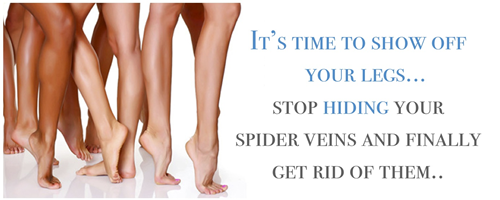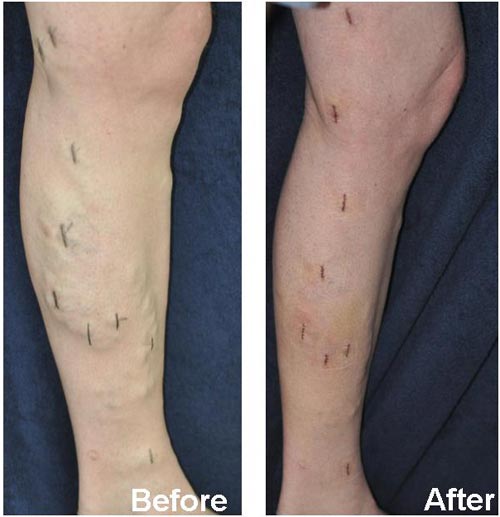Vein Therapy Thailand – Urban Beauty Thailand
Varicose veins are a venous disorder that can cause not only the cosmetic problem but may also cause pain,leg swelling, non healing ulcer and thromboembolism.

Spider Vein, Varicose Vein Therapy at Urban Beauty Thailand
Spider veins are small superficial blood vessels that appear red or blue in the skin. They commonly occur on the legs, but are also found on the face or other areas of the body.
- These dilated blood vessels may be short, unconnected lines, each about the size of a large hair, or connected in a “sunburst” pattern. They may look like a spider web or a tree with branches. Spider veins can occur in a small area where they are not very noticeable, or they can cover a large area of skin and be very unattractive.
- Larger dilated blood vessels called varicose veins may be raised above the skin surface. They may occur with spider veins.
- Patients can have pain that ranges from dull and throbbing to a burning sensation. The larger vessels are more likely to cause discomfort, although smaller blue veins have been shown to cause pain as well.
- If spider veins are bothersome, they can be treated with laser or by injection of a special solution that can destroy them. They can disappear or become much smaller. There is about an 80 – 90 percent chance for a greatly improved appearance.
What causes these blood vessels to become visible?
- The cause of spider veins is not completely known. They seem to run in families. Identical twins can be affected in the same area of the body and to the same extent. The condition rarely occurs as part of an internal disease.
- Spider veins appear in both men and women, but more frequently in women. Female hormones may play a role in their development. Puberty, birth control pills, pregnancy, or hormone replacement therapy may contribute to them. They may also appear after an injury or as a result of wearing tight girdles or hosiery held up with elastic bands. Varicose veins occur mainly from genetic susceptibility.
- Spider veins on the nose or the cheeks of fair-skinned people may be related to sun exposure.
 Can spider veins be prevented?
Can spider veins be prevented?
Spider veins cannot always be prevented. Wearing support hose may minimize unwanted blood vessels from developing. Keeping one’s weight at a normal level and exercising regularly may be helpful, as well as eating a high-fiber diet and wearing low-heeled shoes. Sun protection is important to limit the number of unwanted vessels on the face.
How are unwanted blood vessels on the legs treated?
The injection method is a procedure called sclerotherapy. This procedure has been used for spider veins since the 1930’s, and before that for larger veins. One of several kinds of solutions called sclerosing solution is injected directly into the blood vessel with a very fine needle. The solution irritates the lining of the vessel causing it to swell, stick together, and the blood to clot. Over a period of weeks, the vessel turns into scar tissue that fades, eventually becoming barely noticeable.
Sclerotherapy
- A single blood vessel may have to be injected more than once, some weeks or months apart, depending on its size. A number of vessels can be injected in any one-treatment session. In most cases however only a single treatment can eliminate most of the blood vessels.
- The injection solutions available are slightly different, and the choice of which to use depends on several factors including the size of the vessel. Our doctors will choose a solution that is best for your particular case.
- Occasionally, larger varicose veins are connected to them. In such cases, these vessels should be treated along with spider veins. This can be done by sclerotherapy, or the latest techniques using endovenous laser, stripping, ligation, focal removal of the dilated veins by mini vein surgery or radiofrequency. Great advances have been made in the use of ultrasound to guide the injection of sclerosing solutions. Ultrasound may be used to treat large vessels, as well.
How are spider veins on the face treated?
There are several ways to treat spider veins on the face. Laser, electrodesication, and intense pulsed light have been used successfully.
How successful is sclerotherapy?
- After a single treatment, most veins will vanish, however some patients may need more than one treatment to obtain an 80 – 100 percent improvement.
- As Fading will gradually occur over months.
- Disappearance of treated spider veins is usually achieved.
What about lasers?
- Lasers have been used for more than twenty years. Wavelengths of light are absorbed by the hemoglobin in the blood vessels to destroy them. Many types of lasers, pulsed dye, long-pulsed, variable-pulsed Nd-YAG, and Alexandrite may be used, as well as a non-laser intense pulsed light technique. Your dermatologist will recommend the best type of laser for you.
- Can sclerotherapy or lasers be used on all skin types?
- Yes. All skin types and skin colors respond well, although some skin types require special lasers.
Will insurance cover the treatment of unwanted blood vessels?
- Insurance rarely covers treatment of spider veins but may sometimes cover larger vein treatment.
- If the treatment is solely for cosmetic reasons, it may not be covered.
- To get the procedure covered for larger varicose veins, a second opinion, laboratory studies, or photographs may be required by insurance companies before treatment is started.
- Discuss the costs with your dermatologist before deciding on treatment.
Are there side effects to sclerotherapy?
There are some possible side effects. They include:
- Stinging or pain at the sites of injection, swelling of the ankles or feet, or muscle cramps.This usually occurs when hypertonic saline solution is used and much less with Polidocanol. Hive-like reactions usually go away within 10 to 15 minutes after injection.
- Red, raised areas at the sites of injection. These are similar to hives and the response should disappear within a day or so.
- Brown lines or spots on the skin at the sites of treated blood vessels. Darkened areas may result when blood escapes from treated veins and are probably formed from iron in the blood. These dark areas occur more often in patients who have larger veins treated or those patients that tan easily. In most cases, they disappear within a year, but they may last longer.
- Development of groups of fine red blood vessels near the sites of injection of larger vessels. About one-third of patients develop groups of vessels especially on the thighs. Most disappear by themselves, some need additional injection treatments or laser therapy, a few may last.
- Small, painful ulcers at treatment sites either immediately or within a few days of injection. These occur when some of the solution escapes into the surrounding skin or enters a small artery at the treatment site and can be successfully treated, but it is necessary to inform the dermatologist immediately.
- Temporary bruises. Bruises usually occur after laser treatments and are probably related to the thinness of blood vessel walls. They usually disappear in a few weeks. Occasionally, bruising is seen with sclerotherapy.
- Allergic reactions to sclerosing solutions. Although such reactions are uncommon, they can be treated. Inform your dermatologist immediately.
- Inflammation of treated blood vessels. This is very unusual but when it occurs, it is treated with medications such as aspirin, compression, antibiotics, or heat.
- Lumps in injected vessels. This is coagulated blood and is not dangerous. The dermatologist may drain the blood from these areas a few weeks after injection.
- Burning with discoloration of the skin.
Will treated veins recur?
- Large veins may recur even after surgical procedures. Spider veins may also recur. It may seem that a previously injected vessel has recurred when, in fact, a new spider vein has appeared in the same area.
- Is a history of blood clots in the lungs or legs a reason to avoid therapy?
- Not necessarily, but the procedure must be done with caution to lessen the risk of blood clots.
- Are there other treatment methods?
- Ambulatory phlebectomy, developed by dermatologists, is a method using small punctures to remove varicose veins. The methods for larger varicose veins such as endovenous radiofrequency, and endovenous laser, may be used in combination.
What do I do after treatments?
- Dermatologists may differ in their treatment instructions to patients. Most advise their patients to “clear” the sclerosing solution out of the circulation. Patients are instructed to walk following the procedure.
- Some physicians bandage the injected areas and instruct patients to “compress” the treated vessels by wearing support hose. This may help seal the treated vessels, keep the blood from collecting under the skin, and reduce the development of dark spots. It also may reduce the number of treatments necessary, and the possibility of recurrence. Others put tape dressings on the areas and do not use compression unless the veins are large or in special locations.
- Between treatments, many dermatologists recommend the use of compression or support hose. This may be recommended for people who spend a lot of time on their feet, or work in a standing occupation.
- The treatment of spider and varicose veins can be successful. Treatment methods vary depending on the size and location of the abnormal veins. The injection method is presently the method most commonly used, but great advances have been made recently in other techniques such as lasers.
When you contact Urban Beauty Thailand, we will not only set you up with our best dermatologists team, all our prices are upfront. When you book with us, there are no hidden fees or charges.



